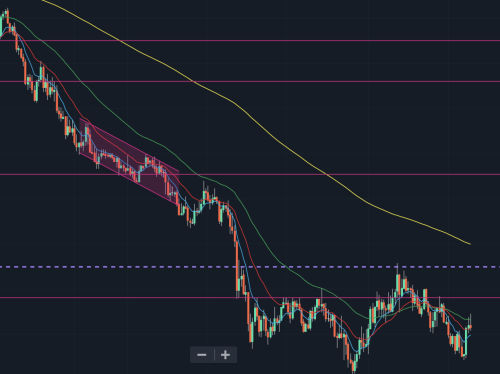The support forum is built with (1) General and FAQ forums for common trading queries received from aspiring and experienced traders, and (2) forums for course video topics. How to Trade Price Action and How to Trade Forex Price Action videos are consolidated into common forums.
Brooks Trading Course social media communities
sometimes I have a little trouble understanding how to measure a MM. In particular I am referencing the 5min E-mini on 2/10/22. Why is the first leg of the MM calculated only using bars 1,2, and 3. Why should I not use bars 4-8 Is there something significant about bar 4? Is it because bar 4 only goes up to but does not exceed the high of the previous bar?
Thanks for your help
Robert
Bars 1 through 3 are breakouts of something. Bar 4 paused the breakout. After a significant breakout, there is a 60% chance of a measured move up of the size of the breakout. That is to say, there is a 60% chance that the market will move 'n' points above before it moves 'n' points below.
Like you said, bar 4 failed to break out above the high of bar 3. That should not be happening if the market is still breaking out thereby indicating a pause of the breakout. You can see, the breakout of bar 5 did not have a great follow through. This is an indication that the breakout phase has ended.
Do we count measure move works only on breakout? Say the market channel up and then pause. Is that consider that we will do another measure move?
I asked this because I've seen a market channel, and then spike for the same points as the channel height.
Do we count measure move works only on breakout?
Yes, since most of the time the probability of any reasonable setup working is between 40-60%, for the markets to create a MM up or down, a breakout(could be of anything) is necessary for the probability to be high enough for a MM.
Say the market channel up and then pause. Is that consider that we will do another measure move?
A channel is a flag, depending on context. A bull channel is a bear flag and a bear channel is a bull flag. Whenever the market is in a channel, there is a 70-75% chance that the market will breakout in the opposite direction of the channel(bear breakout in case of bull channel and vice-versa).
I asked this because I've seen a market channel, and then spike for the same points as the channel height.
In 25% of the cases, the market strongly breaks a channel in the direction of current trend(bull breakout of a bull channel and vice-versa). Usually, such channels are in the shape of wedges and you can see the market make a MM equal to the size of the wedge(starting point of the 1st leg to the end point of the 3rd leg).
As you can understand, this is a rare event - instead of the trend gradually weakening, the market creates a breakout and the trend becomes stronger instead.
Wait, there are a lot of probabilities thrown around here.
So a break out has 40-60% of making a MM.
A channel has a 75% of reversing and 25% of breakout and going up further.
So if I see the market in a channel, I should always do the opposite of the trend since I have a higher probability of it breaking out? I thought the probability is higher with trend.
But most breakout have 80% of failure rate according to Al.
I'm so confused now with all these probabilities.
From my picture above, the channels today were working their way down, pull-backed and accelerated even more. Only when it hit some sort of resistance it then went into a large trading range.
So a break out has 40-60% of making a MM.
Actually, that's not what I said. I said, only when the probability is about or greater than 60%(which is found during a breakout), can you expect a MM. Other times, you can either buy or sell reasonable setups and can make money if you manage your trade correctly (this is what is found on 90% bars on a chart).
So if I see the market in a channel, I should always do the opposite of the trend since I have a higher probability of it breaking out? I thought the probability is higher with trend.
Kindly review the section where Al has covered channels. He says that a channel is a flag(as I explained above). You can expect a bull channel to have a bear breakout on 75% cases and vice-versa. However, the bear breakout can happen at any point of time(even after channeling for a long enough time that you bleed to death on such a trade). Al also says that every time there is a breakout of a channel up or down, there is a 75% chance that the breakout would fail within 5 bars(on the highest time-frame where such channel is discernible.
So yes, the probability is higher with the trend. That's why he keeps repeating through the course about tight channels and how any attempted reversal of a tight channels is going to lead to a minor reversal and there will be a second leg in the direction of the channel (original trend).
But most breakout have 80% of failure rate according to Al.
Most breakout attempts during a TR fail(80%) and similarly, most reversal attempts during a trend fail(80%). It is because the markets have inertia and it resists change.
I'm so confused now with all these probabilities.
It is quite normal as a beginner. I suspect you haven't covered even 20% of the course. You'll get used to it with enough practice and repetition. Al keeps repeating, you have to put in the hard work - no one else is going to do it for you.

